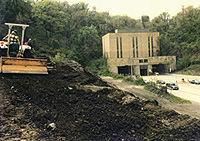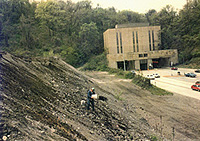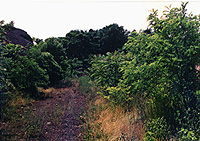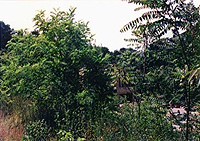Slag Soil
Remediation
Text by John
Buck, Civil and Environmental Consultant
What is slag?
In producing steel, iron ore
is introduced into a blast furnace along with limestone and coke. The
limestone decomposes and melts into a slag that removes phosphorus and
sulfur impurities from the liquid iron. Slag is highly alkaline
(pH 9.5-11) and does not retain enough water for plants to germinate.

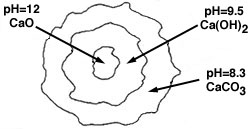
Diagram of a slag particle.
| Element |
Average Amount |
Element |
Average Amount |
| Carbon |
1.70% |
Nitrogen |
0.03% |
| Phosphorus |
0.12% |
Sulfur |
0.10% |
| Potassium |
0.02% |
Calcium |
4.35% |
| Magnesium |
1.34% |
Zinc |
0.03% |
| Copper |
0.01% |
Aluminum |
0.27% |
| Manganese |
0.85% |
Iron |
6.18% |
| Molybdenum |
0.00% |
Cadmium |
30.69 ppm |
| Chromium |
671.4 ppm |
Lead |
167.1 ppm |
| Mercury |
0.02 ppm |
Nickel |
88.53 ppm |
| Arsenic |
6.1 ppm |
Selenium |
0.52 ppm |
Chart from Nine
Mile Run: A Study of the Reclamation and Sustainable Redevelopment of
a Brownfield Site by the Department of Engineering and Public Policy,
H. John Heinz School of Public Policy and Management, and Department
of Social Decision Sciences of Carnegie Mellon University.
What do plants
need to survive?
Absence of intolerable physical
stress (e.g., landslides).
Absence of intolerable chemical stress (phytotoxicity or plant toxicity).
Adequate water storage to avoid drought (soil that retains water).
Adequate nutrient availability.
Anchorage (a soil that is penetrable by roots, stable support).
Aeration (free exchange of soil gasses with the atmosphere).
Every soil (and alternative
growing medium) has assets and deficits with regard to the above plant-support
criteria. In response to the range of soil conditions, particular plant
species have evolved adaptations to less-than-idea soil conditions.
Adapted plant communities have sprung up on the Nine Mile Run slag.
So what
kinds of plants grow on slag?
Characteristics of Trees
Growing on Slag
| Common Name |
Scientific Name |
pH |
Root Pattern |
Longevity |
| Boxelder |
Acer negundo |
(6.5-7.5) |
Deep laterals |
Short |
| Red Mulberry |
Morus rubra |
(6.3-8.0) |
Taproot or Deep Laterals |
Short |
| Sycamore |
Planatus occidentalis |
(6.6-8) |
Shallow |
Long |
| Bigtooth Aspen |
Populus grandidenta |
(5.1-6.3) |
Shallow |
Short |
| Smooth Sumac |
Rhus glabra |
(6.1-7.0) |
Shallow |
Short |
| Staghorn Sumac |
Rhus typhina |
(6.1-7.0) |
Shallow |
Short |
| Black Locust |
Robina pseduacacia |
(5.1-7.7) |
Shallow |
Short |
| American Elm |
Ulmus Americana |
(6.6-8.0) |
Shallow to Deep Lateral |
Medium |
Chart from
Nine Mile Run: A Study of the Reclamation and Sustainable Redevelopment
of a Brownfield Site by the Department of Engineering and Public Policy,
H. John Heinz School of Public Policy and Management, and Department
of Social Decision Sciences of Carnegie Mellon University.
So what has to
be done if we are to grow plants in slag?
Successful vegetation establishment requires a combination of the following:
- Introduction of species
adapted to soil conditions and
- Modification of soils
to allow a wider range of species to become established.
To that end, the soil treatment
options include the following:
- Regrading slag
to reduce slag/soil creep.
- Breaking up fused slag
to increase root penetration (e.g., "ripping" with a bulldozer).
- Mixing materials into
the slag to improve water retention. Water
retention amendment systems could be temporary, lasting long enough
to establish plants with deep root systems, or permant, widening the
range of species.
- Adding fertilizers, chemical
additives, and/or organic nutrient sources (e.g. compost, manure)
to improve nutrient availability.
- Introducing nitrogen-fixing
plants (legumes) to naturally maintain nitrogen fertility. Examples
include clovers, birdsfoot trefoil, black locust, bristly locust.
- Covering or "capping"
the slag with topsoil, or the use of slag/soil mixtures as growing
media.
- Heavy mulching to minimize
erosion, shelter seed and seedlings, and reduce moisture losses.
- Use of adapted plant
species, and a successional process (starting with fast growing plants
and transitioning over time to more desirable species).
Case Study:
Squirrel Hill Slag Heap Remediation
Spring 1986:
I developed a remediation plan for the northern slopes of the Squirrel
Hill Slag Heaps with funding from the Pennsylvania Conservancy. These
steep slopes were planted by rappeling, augering and chopping planting
holes through the slag. Bare-root bristly locust seedling were placed
and back filled with a slurry of peat and manure. Another element of the
remediation plan involved surface remediation and application of seeds.
A mixture of mushroom compost and fertilizers was laid down by volunteers
working in bucket brigade style. Black locust, grasses, wildflowers, buckwheat
and birdsfoot trefoil seeds were spread in seed form. The bottom images
shows the same site six years later. Note the 12 foot high black locust
established from seed.
|


